This article was published in Scientific American’s former blog network and reflects the views of the author, not necessarily those of Scientific American
Regular readers of this blog might know that I have a special research interest in ichthyosaurs, the (mostly) shark-shaped marine reptiles of the Mesozoic, and in particular with parvipelvian ichthyosaurs: Parvipelvia being the clade characterised by a reduced pelvis, enlarged tail fin and other features linked to increased ‘thunniformity’, if you will. I haven’t published as much on parvipelvians as I would have liked, but when have you heard that before.
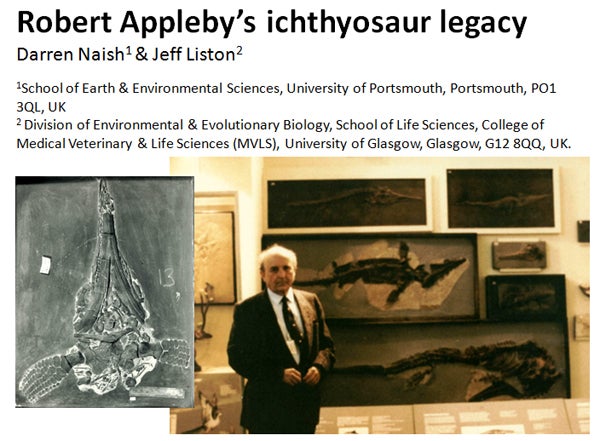
The cover slide to a conference presentation given in 2011. Credit: Valerie Appleby and Darren Naish
For some considerable time now I’ve been involved in what’s known as the Robert Appleby Ichthyosaur Legacy project. Catchy, no? Robert Appleby, based for most of his career at the University of Cardiff, Wales, was one of the few 20th century scientists to work in dedicated fashion on ichthyosaurs. Today he’s best remembered for a few papers on the iconic Jurassic parvipelvian Ophthalmosaurus (Appleby 1956, 1958, 1961), and it has to be said that he never published all that much during his lifetime. There is actually a list of reasons for that, all of which will be discussed once myself and my co-authors finish compiling the biographical data on Appleby we’ve amassed. For, working together with Jeff Liston, Valentin Fischer, Judith Pardo-Pérez and others (the late, great Arthur Cruickshank was also an integral part of the team), I’ve been working to salvage and publish the many incomplete and near-finished manuscripts and papers that Appleby left behind. The results so far include our 2012 paper on the ophthalmosaurid Acamptonectes from Germany and the UK (Fischer et al. 2012) and our 2013 paper on Malawania from Iraq (Fischer et al. 2013), and more is set to appear.
On supporting science journalism
If you're enjoying this article, consider supporting our award-winning journalism by subscribing. By purchasing a subscription you are helping to ensure the future of impactful stories about the discoveries and ideas shaping our world today.
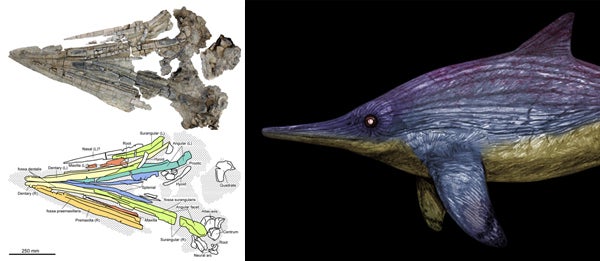
At left, the skull of the Early Cretaceous ophthalmosaurid parvipelvian Acamptonectes densus; at right, a life reconstruction of the same taxon by C. M. Kosemen. Credit: Fischer et al. 2012 (left), C. M. Kosemen (right)
Indeed, the impression that Appleby never did that much belies the ridiculous amount of ichthyosaur-themed stuff he actually did but never published, and for the full story on that you’ll have to wait, sorry. Among those things he did publish was his 1979 paper on the ostensible new British parvipelvian Protoichthyosaurus, two species of which were recognised in the same paper (P. prostaxalis and P. prosostealis), both of which were from the Lower Jurassic of south-western England, both of which were argued to be valid on the basis of the configuration of their fore-paddle bones and on the proportions of their skull and limb girdle bones (Appleby 1979).
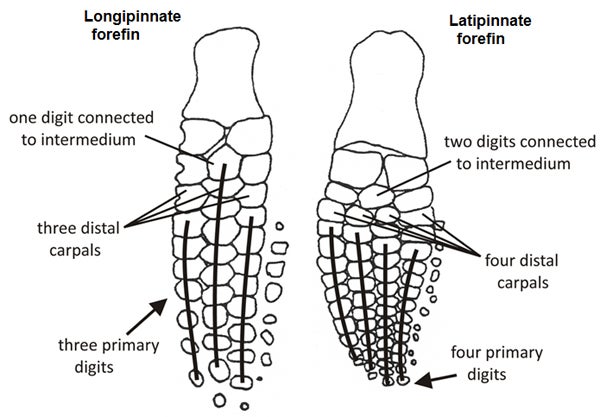
The longipinnate-latipinnate division is not really used any more, but - back when it was - this is what you would look for. Credit: Darren Naish
Appleby’s take on the pattern of ichthyosaur evolution – and on the taxonomic decisions that should be favoured to reflect that pattern – looks anachronistic today. At the time, ichthyosaurs were thought to consist of two main groups: longipinnates (with three primary forefin digits, three distal carpals and a single digit attached to the intermedium) and latipinnates (with four primary forefin digits, four distal carpals and two digits attached to the intermedium). Protoichthyosaurus didn’t fit with this division (indeed, it was soon to fall to pieces anyway), but – rather than give up with it – Appleby’s solution was to recognise an intermediate group – Heteropinnatoidea – for Protoichthyosaurus and another trouble-maker: Leptonectes.
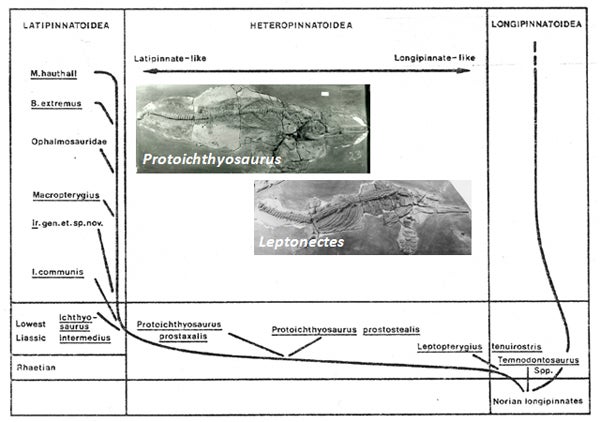
The Appleby solution to problem taxa like Protoichthyosaurus: create a new group to account for their 'intermediate' anatomical features. This diagram - incorporating information from Appleby (1979) - places Protoichthyosaurus and Leptonectes within the new group Heteropinnatoidea. Credit: Appleby 1979
Alas, it didn’t last. Chris McGowan dismantled the latipinnate-longipinnate division in 1976, Heteropinnatoidea was abandoned entirely, and Protoichthyosaurus itself was ignored and soon assumed to be without merit and undeserving of recognition: within the (small!) ichthyosaur research community, the thinking for some time has been that the specimens concerned can be assigned to Ichthyosaurus communis (McGowan & Motani 2003). Indeed, the great problem with Ichthyosaurus is that forefin diversity is so great, so baffling, that extracting convincing phylogenetically and taxonomically meaningful signals from among its hundreds of known specimens is difficult. On the one hand, it’s conceivable that the variation is such that all known specimens can be interpreted as variants of one super-plastic, widespread taxon…
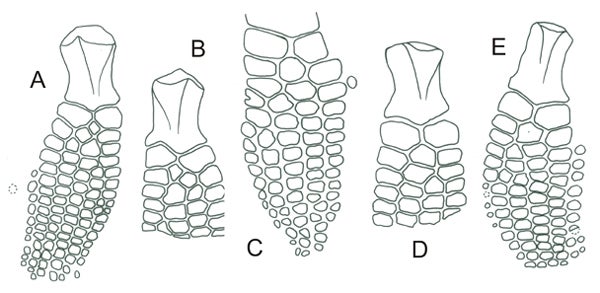
Warning: ichthyosaur paddle bone configurations can be bad for your mental health, engage responsible and in small doses. Some of the paddles here (from Appleby 1979) belong to Protoichthyosaurus. Credit: Appleby 1979
On the other hand, there are perhaps enough differences that allow us to extract some taxa from the mess. Since McGowan’s work of the 1970s, it’s been largely agreed that at least a few Ichthyosaurus species warrant recognition alongside I. communis (namely I. brevis, I. conybeari and perhaps I. intermedius). And in a series of recent papers, my colleague Dean Lomax and his collaborators have re-analysed a great many of the specimens referred to Ichthyosaurus, arguing that at least some possess unusual features that warrant their recognition as separate species. I. anningae, I. somersetensis and I. larkini have now been added to the list.
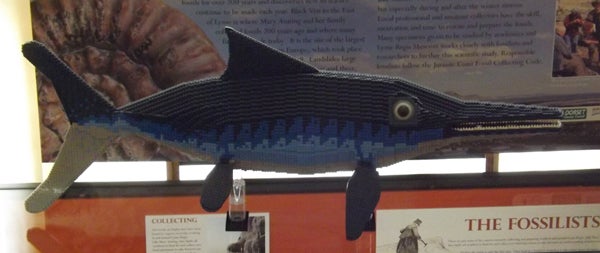
In the unlikely event that you've forgotten what Ichthyosaurus looked like, here's one made from lego, on display at the Lyme Regis Museum. Credit: Darren Naish
What, then, of Protoichthyosaurus? My involvement in the Appleby Legacy project led me to think hard about this ostensible taxon for work I did back in 2011; while coding as many Ichthyosaurus specimens as I could for an analysis (hat-tip to Andrea Cau for help), I found the Protoichthyosaurus specimens to – in some data-runs – fall outside of Ichthyosaurus, shock horror. In a talk that I gave about the Appleby Legacy project at a conference that year, I went as far as saying that Protoichthyosaurus may warrant distinction after all.
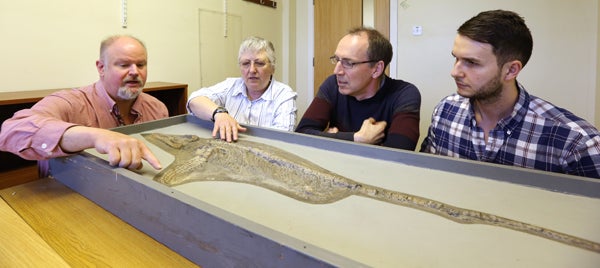
Bill Wahl, Prof. Judy Massare, Dr David Large & Dean Lomax examine the new species of Protoichthyosaurus described in their new paper (Lomax et al. 2017). Credit: University of Nottingham, Dean Lomax
And now we come to the reason for this article. Dean and colleagues have recently been looking at Protoichthyosaurus too, and – yes, the word on the street is true – they do indeed find Protoichthyosaurus to be valid, to be an additional ichthyosaurid taxon outside of Ichthyosaurus, and they even propose the existence of a new Protoichthyosaurus species… which they call P. applebyi (Lomax et al. 2017). Furthermore, they’ve identified additional Protoichthyosaurus specimens from across England and also from Wales. That’s hardly a far-flung, trans-oceanic distribution, but it at least shows that Protoichthyosaurus was reasonably widespread during the Early Jurassic, and not so provincial as to be restricted to one small ocean basin or whatever. The features that make Protoichthyosaurus worthy of recognition concern the configuration of forefin bones (and mostly concern the way in which various of the proximal and distal carpals interact) as well as a combination of skull features not seen in other parvipelvians (Lomax et al. 2017).
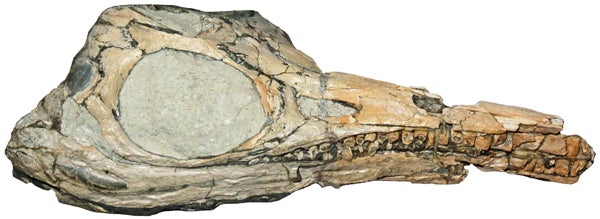
3D skull of Protoichthyosaurus prostaxalis featured in Lomax et al. (2017), with the large sclerotic ring so characteristic of ichthyosaurs not preserved in place. Credit: University of Birmingham, Lapworth Museum, Dean Lomax
As always, remember that decisions made as goes phylogeny and taxonomy are not definitive; they do not close the case on this issue (namely, here, the validity of Protoichthyosaurus). Science is a dialogue, and we’re in the middle of a new research cycle on Lower Jurassic parvipelvian taxonomy and phylogeny, with much work still on-going (in addition to the work of Dean and his colleagues I have to mention my former PhD student Jessica Lawrence-Wujek. Jessica successfully defended her Ichthyosaurus-themed thesis in March of this year).
-University-of-Nottingham-Dean-R-Lomax-Tetrapod-Zoology.jpg?w=600)
Holotype of Protoichthyosaurus applebyi (UNM.G.2017.1), a specimen at the University of Nottingham Museum, Nottingham, UK. Credit: University of Nottingham, Dean Lomax
However, if upheld by future work, one thing this new study shows is that Ichthyosauridae – the parvipelvian group that includes Ichthyosaurus, Protoichthyosaurus and – according to some studies (Fischer et al. 2013) – their Cretaceous relative Malawania – was more speciose and ‘more successful’ than we thought before. While our record of these particular ichthyosaurs is mostly limited to the UK so far (a quirk of geological exposure), it seemingly means that a bush-like radiation of ichthyosaurids occurred, its various lineages experimenting with different body sizes, paddle configurations, skull shapes and, presumably, ways of making a living. This is a new and exciting idea, and we can look forward to seeing what happens next.
My thanks to Dean for his help in getting this article together, and to my collaborators on the Appleby Legacy project. For previous Tet Zoo articles on ichthyosaurs, see...
An Arthurian adventure, part II: more fossil marine reptiles than are good for your health
Rigid Swimmer and the Cretaceous Ichthyosaur Revolution (part I)
Malawania from Iraq and the Cretaceous Ichthyosaur Revolution (part II)
The Dinosaurs of Crystal Palace: Among the Most Accurate Renditions of Prehistoric Life Ever Made
Refs - -
Appleby, R. M. 1956. The osteology and taxonomy of the fossil reptile Ophthalmosaurus. Proceedings of the Zoological Society, London 126, 403-447.
Appleby, R. M. 1958. Ophthalmosauridae in the collections of the Leicester and Peterborough Museums. Leicester Museums and Art Gallery, Department of Geology, pp. 47.
Appleby, R. M. 1961. On the cranial morphology of ichthyosaurs. Proceedings of the Zoological Society, London 137, 333-370.
Appleby, R. M. 1979. The affinities of Liassic and later ichthyosaurs. Palaeontology 22, 921-946.
Lomax, D. R., Massare, J. A. & Mistry, R. 2017. The taxonomic utility of forefin morphology in Lower Jurassic ichthyosaurs: Protoichthyosaurus and Ichthyosaurus. Journal of Vertebrate Paleontology DOI: 10.1080/02724634.2017.1361433
McGowan, C. & Motani, R. 2003. Handbook of Paleoherpetology Part 8 Ichthyopterygia. Verlag Dr. Friedrich Pfeil, Munich.